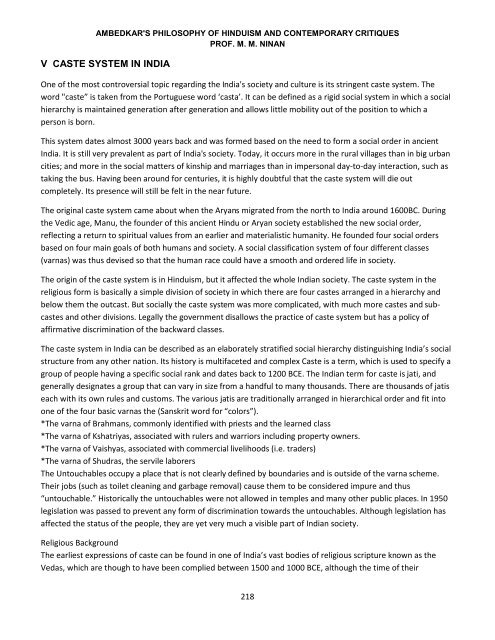Ambedkar-Philosophy of Hinduism
Create successful ePaper yourself
Turn your PDF publications into a flip-book with our unique Google optimized e-Paper software.
AMBEDKAR'S PHILOSOPHY OF HINDUISM AND CONTEMPORARY CRITIQUES<br />
PROF. M. M. NINAN<br />
V CASTE SYSTEM IN INDIA<br />
One <strong>of</strong> the most controversial topic regarding the India's society and culture is its stringent caste system. The<br />
word "caste” is taken from the Portuguese word ‘casta’. It can be defined as a rigid social system in which a social<br />
hierarchy is maintained generation after generation and allows little mobility out <strong>of</strong> the position to which a<br />
person is born.<br />
This system dates almost 3000 years back and was formed based on the need to form a social order in ancient<br />
India. It is still very prevalent as part <strong>of</strong> India's society. Today, it occurs more in the rural villages than in big urban<br />
cities; and more in the social matters <strong>of</strong> kinship and marriages than in impersonal day-to-day interaction, such as<br />
taking the bus. Having been around for centuries, it is highly doubtful that the caste system will die out<br />
completely. Its presence will still be felt in the near future.<br />
The original caste system came about when the Aryans migrated from the north to India around 1600BC. During<br />
the Vedic age, Manu, the founder <strong>of</strong> this ancient Hindu or Aryan society established the new social order,<br />
reflecting a return to spiritual values from an earlier and materialistic humanity. He founded four social orders<br />
based on four main goals <strong>of</strong> both humans and society. A social classification system <strong>of</strong> four different classes<br />
(varnas) was thus devised so that the human race could have a smooth and ordered life in society.<br />
The origin <strong>of</strong> the caste system is in <strong>Hinduism</strong>, but it affected the whole Indian society. The caste system in the<br />
religious form is basically a simple division <strong>of</strong> society in which there are four castes arranged in a hierarchy and<br />
below them the outcast. But socially the caste system was more complicated, with much more castes and subcastes<br />
and other divisions. Legally the government disallows the practice <strong>of</strong> caste system but has a policy <strong>of</strong><br />
affirmative discrimination <strong>of</strong> the backward classes.<br />
The caste system in India can be described as an elaborately stratified social hierarchy distinguishing India’s social<br />
structure from any other nation. Its history is multifaceted and complex Caste is a term, which is used to specify a<br />
group <strong>of</strong> people having a specific social rank and dates back to 1200 BCE. The Indian term for caste is jati, and<br />
generally designates a group that can vary in size from a handful to many thousands. There are thousands <strong>of</strong> jatis<br />
each with its own rules and customs. The various jatis are traditionally arranged in hierarchical order and fit into<br />
one <strong>of</strong> the four basic varnas the (Sanskrit word for “colors”).<br />
*The varna <strong>of</strong> Brahmans, commonly identified with priests and the learned class<br />
*The varna <strong>of</strong> Kshatriyas, associated with rulers and warriors including property owners.<br />
*The varna <strong>of</strong> Vaishyas, associated with commercial livelihoods (i.e. traders)<br />
*The varna <strong>of</strong> Shudras, the servile laborers<br />
The Untouchables occupy a place that is not clearly defined by boundaries and is outside <strong>of</strong> the varna scheme.<br />
Their jobs (such as toilet cleaning and garbage removal) cause them to be considered impure and thus<br />
“untouchable.” Historically the untouchables were not allowed in temples and many other public places. In 1950<br />
legislation was passed to prevent any form <strong>of</strong> discrimination towards the untouchables. Although legislation has<br />
affected the status <strong>of</strong> the people, they are yet very much a visible part <strong>of</strong> Indian society.<br />
Religious Background<br />
The earliest expressions <strong>of</strong> caste can be found in one <strong>of</strong> India’s vast bodies <strong>of</strong> religious scripture known as the<br />
Vedas, which are though to have been complied between 1500 and 1000 BCE, although the time <strong>of</strong> their<br />
218


















